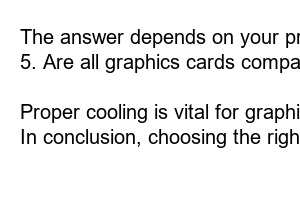그래픽카드 비교
Graphics Card Comparison: Finding the Perfect Fit for Your PC
Are you in the market for a new graphics card but overwhelmed by the vast array of options available? Look no further! In this blog post, we will provide a comprehensive comparison of graphics cards, making it easier for you to choose the perfect fit for your PC needs.
1. What is a graphics card?
A graphics card, also known as a GPU (Graphics Processing Unit), is a critical component of your computer that renders images, videos, and animations onto your screen. It enhances the quality of your visual experience and plays a significant role in gaming, video editing, and other graphic-intensive tasks.
2. Performance comparison: AMD vs. NVIDIA
When it comes to graphics card manufacturers, two giants dominate the market: AMD and NVIDIA. *AMD* offers a range of budget-friendly options with excellent performance, while *NVIDIA* specializes in high-end graphics cards that deliver unmatched power and game-changing features.
3. Memory and VRAM: Understanding the Difference
Memory and VRAM (Video Random Access Memory) are crucial factors to consider when comparing graphics cards. While memory affects general system performance, VRAM influences gaming performance specifically. *Higher memory* and *VRAM capacities* allow for smoother multitasking and more demanding graphics rendering, ensuring an immersive gaming experience.
4. Power Consumption: Balancing Performance and Efficiency
Choosing a graphics card with optimal power consumption is essential for maintaining the stability and longevity of your PC. *AMD’s* graphics cards tend to consume more power but offer superior performance, while *NVIDIA* focuses on power efficiency without compromising on capabilities.
5. Compatibility and Connectivity: The Right Fit for Your System
Before making a purchase, ensure that the graphics card you choose is *compatible* with your motherboard and power supply. *PCIe compatibility* is critical for modern systems, and considering the available *output connectors* (such as HDMI, DisplayPort, or DVI) allows you to connect your desired display devices seamlessly.
6. Price Point: Finding the Best Value
Graphics cards are available at various price points to accommodate different budgets and requirements. It’s essential to strike a balance between performance and affordability. Remember, the most expensive isn’t always the best choice for your needs. Do thorough research and read reviews to find the best value for your money.
Frequently Asked Questions (FAQs):
1. Which brand offers better gaming performance?
Both AMD and NVIDIA offer exceptional gaming performance, and it ultimately depends on your specific requirements. Do you prioritize raw power or cost-effectiveness? Assess your needs and make a decision accordingly.
2. Does more VRAM automatically mean better performance?
More VRAM provides an advantage when running graphically demanding games or using high-resolution displays. However, other factors such as GPU architecture and clock speed also contribute to performance. It’s important to consider the overall package, not just VRAM capacity.
3. Can I mix different graphics card brands in a multi-GPU setup?
In most cases, multi-GPU setups require identical graphics cards from the same brand. Mixing different brands may result in compatibility issues, performance degradation, or even system instability. Stick to the same brand if you plan to utilize a multi-GPU configuration.
4. Should I prioritize power consumption or performance?
The answer depends on your priorities and the intended use of your PC. If energy efficiency and a cooler system are crucial, consider a graphics card with lower power consumption. However, if you’re a power user or gamer seeking top-notch performance, a slightly higher power consumption may be acceptable.
5. Are all graphics cards compatible with my motherboard?
Graphics card compatibility depends on several factors, including the motherboard’s PCIe slot type, form factor, and power supply requirements. Refer to your motherboard’s specifications and the graphics cards’ compatibility list to ensure a seamless fit.
6. How can I ensure efficient cooling for my graphics card?
Proper cooling is vital for graphics card longevity and performance. Make sure your PC case has appropriate airflow and consider additional fans or liquid cooling solutions if necessary. Regularly clean the graphics card to remove dust buildup, ensuring optimal cooling efficiency.
In conclusion, choosing the right graphics card involves considering factors such as performance, memory and VRAM, power consumption, compatibility, and price point. Assess your needs, research thoroughly, and make an informed decision to elevate your PC’s visual experience to new heights.

